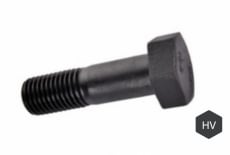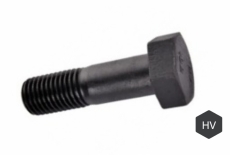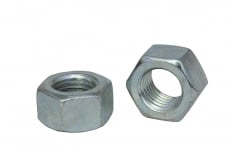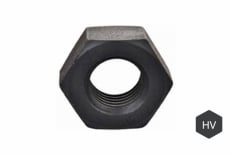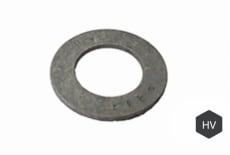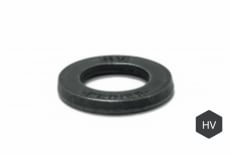The concept of material hardness
The hardness of a material is one of the most important characteristics that determines its ability to resist deformation and destruction. This is the ability of the surface layer of the material to resist elastic and plastic deformation or destruction under the influence of a harder body (indenter).
An indenter is a hard body that deforms little (for example, diamond, hard alloy or hardened steel) and has a certain geometric shape (sphere, pyramid, cone, needle), which is pressed into the surface of a sample or product.
Hardness testing is different from other methods. Hardness is determined through the creation of contact stresses that occur when bodies press against each other on a small contact area.
Hardness is assessed by the magnitude of the obtained deformation. Depending on the test method, the properties of the tip and the material, the hardness can be determined by different criteria.
Hardness can be measured in a variety of ways: by pressing the tip under a static or dynamic load, by scratching the surface, or by measuring the rebound of a free-falling tip.
Depending on the test methods and conditions, hardness indicators can characterize both elastic properties and resistance to small or large plastic deformations, as well as the ability of the material to break.
Various methods are used to assess hardness, among which the Rockwell and Brinell methods are the most common. Both methods have their own characteristics and areas of application, so understanding their differences is important for the correct choice of hardness measurement method and further classification of steel grades. Read more about stainless steel grades in the article.
Hardness measurement methods
The existing hardness measurement methods differ significantly in the shape of the indenter, loading conditions, and hardness calculation methods. The choice of method is determined by many factors, such as the hardness of the sample material, its dimensions, the thickness of the layers to be measured, and others.
The methods of determining the hardness are divided into static and dynamic depending on the speed of loading, and according to the method of application, into methods of pressing and scratching. The most common are the methods that use static pressing of the indenter into the surface of the sample.
The main (static) hardness testing methods include three standard methods named after their inventors:
- Brinell method,
- Vickers method,
- Rockwell method.
During pressing with a heavy load, the surface layers of the metal under the tip undergo plastic deformation. After removing the load, an imprint remains on the sample. This deformation is limited to a small volume of metal surrounded by an undeformed part. When measuring hardness, not only ductile metals are subject to plastic deformation, but also low-plastic ones.
A small volume of deformed metal, the possibility of conducting tests on surfaces of various shapes and sizes, as well as on thin layers without specially made samples, make these tests quick and simple. They allow you to evaluate their properties without destroying the products, because there is a quantitative relationship between the hardness of plastic materials and their mechanical properties, in particular the strength limit. This makes hardness testing an important method of mass control of materials.
The value of hardness, like other mechanical properties, depends on the chemical composition and structure of the material. Therefore, hardness measurements are widely used in industry to assess the properties of parts and the quality of heat treatment.
Because hardness measurements do not destroy parts, they are often used for continuous monitoring, while determination of strength and ductility characteristics is carried out selectively.
There are two ways to determine hardness by compression:
- Measurement of macrohardness.
- Measurement of microhardness.
When measuring macrohardness, the indenter is pressed into the material to a considerable depth, which depends on the load. For example, some methods use a steel ball with a diameter of up to 10 mm, which makes it possible to estimate the "average" hardness of the material.
The choice of the shape, size of the indenter and the magnitude of the load depends on the purpose of the test, the structure of the material, the expected properties, the condition of the surface and the dimensions of the sample. For materials with a heterogeneous structure, it is advisable to use larger tips, while for fine-grained and homogeneous - smaller ones.
When measuring microhardness, the hardness of individual grains and structural components is determined, so the load should be small.
In all test methods, it is important to properly prepare the surface layer of the sample so that it accurately characterizes the material. All surface defects, such as scale or dents, must be removed. The surface quality requirements depend on the indenter and the load: the smaller the indentation depth, the higher the surface cleanliness should be. It should also be ensured that the properties of the surface layer do not change due to slander or heating during grinding and polishing.
The results of hardness tests depend on the duration of the application of the load and the duration of exposure under the load. At constant
load P, the linear size of the imprint is equal to:
d = b×tn,
Where t is the indenter's exposure time under load;b, n - coefficients that depend on the properties of the material and the value of Р.
Short-term and long-term hardness are distinguished depending on t. Standard methods determine short-term hardness at room temperature. Here, of course, t = 10 - 30 s. Long-term hardness is evaluated at elevated temperatures and is used as a characteristic of the heat resistance of the material. When determining the hardness by all methods (except microhardness), the total resistance of the metal to the introduction of an indenter into it is measured, and the average hardness of all available structural components is obtained. Therefore, the size of the imprint that remains after removing the load should be much larger than the grain size of the individual structural components (the diameter or diagonal length of the imprints when measuring hardness varies from 0.1 - 0.2 to several millimeters).
Brinell method
The Brinell method consists in pressing a steel ball into the material under a certain load. After removing the load, measure the diameter of the impression. Brinell hardness is determined by a formula that takes into account the diameter of the impression, the applied load and the diameter of the ball.
Advantages of the Brinell method:
Versatility: The Brinell method can be used to measure the hardness of a wide range of materials, from soft to hard.
Ease of calculation: Brinell hardness is calculated using a simple formula.
When measuring the Brinell hardness, a steel ball with a diameter D is pressed into the sample under a load P for a certain time, and after the load is removed, the diameter d of the impression left on the surface is measured. In the surface layer under the indenter, there is intense plastic deformation (Fig. 1), and the diameter of the impression is smaller, the higher the resistance of the sample material to the deformation. The Brinell hardness number (HB) is the ratio of the load P acting on the indenter with a diameter D to the area S of the impression:
|
The area of the imprint can also be determined by the depth of the indenter h: S = p×D×h The hardness number is indicated by HB, and the dimension (kgf/mm2) or MPa in accordance with the standard is not written. |
Fig.1 Diagram of the stress state in the zone of plastic deformation (shaded) when determining Brinell hardness
|
When determining Brinell hardness, indenters of one of three diameters are used - 2.5, 5 and 10 mm. They are made of steel with a hardness of at least 850 kgf/mm2. Using the Brinell method, you can test materials with a hardness from HB8 to HB450. With a higher hardness of the sample, the indenter ball is finally deformed by an amount exceeding the standardized tolerance. To measure the hardness of metals and alloys according to Brinell, special devices are used - hardness testers. |
Fig. 2. Brinell device with a mechanical drive.
Rockwell method
When determining the hardness according to the Brinell and Vickers methods, it is necessary to measure the size of the impression obtained as a result of indentation and record the applied load. These data allow you to calculate the hardness, but the process itself remains quite time-consuming, even with the use of tables to simplify the calculations.
The Rockwell method, on the other hand, is based on measuring the depth of the indenter pressing into the material, which greatly simplifies the process. Here, the definition of hardness is reduced to the measurement of this depth, which allows you to automate the entire process and get results faster. This makes the Rockwell method one of the most popular in practice.
However, if the indentation depth is considered as a direct indicator of hardness, a paradox arises: soft materials that have a large indentation depth appear harder, while hard materials, accordingly, appear softer.
The Rockwell method is based on measuring the penetration depth of an indenter (point or ball) under the action of two consecutive loads. The first load (preliminary) creates a constant condition for further measurement, and the second (main) determines the depth of penetration.
Advantages of the Rockwell method:
- Speed of measurement: The Rockwell method is relatively fast, allowing a large number of measurements to be made in a short time.
- Accuracy: the method provides high measurement accuracy, especially for solid materials.
- Small impression: the size of the impression from the indenter is small, which allows you to measure the hardness of thin parts and coatings.
- Ease of use: Rockwell hardness testers are relatively easy to use.
Comparison of Rockwell and Brinell methods. Hardness scale.
|
Characteristic |
Rockwell method |
Brinell method |
|
The principle of measurement |
Measurement of penetration depth |
Measurement of the diameter of the impression |
|
Indicator |
Point or ball |
Steel ball |
|
Scales |
Various scales (A, B, C, etc.) |
One scale |
|
Measuring speed |
High |
Relatively low |
|
Precision |
High for solid materials |
High for soft materials |
|
Print size |
Little |
Great |
|
Scope of application |
Solid materials, fine details, coatings |
A wide range of materials |
The hardness comparison table of HV, HB, HRC is usually used
| Tensile strength (N / mm2) |
Vickers hardness HV |
Brinell hardness HB |
Rockwell hardness HRC |
| 255 | 80 | 76.0 | - |
| 270 | 85 | 80.7 | - |
| 285 | 90 | 85.2 | - |
| 305 | 95 | 90.2 | - |
| 320 | 100 | 95.0 | - |
| 335 | 105 | 99.8 | - |
| 350 | 110 | 105 | - |
| 370 | 115 | 109 | - |
| 380 | 120 | 114 | - |
| 400 | 125 | 119 | - |
| 415 | 130 | 124 | - |
| 430 | 135 | 128 | - |
| 450 | 140 | 133 | - |
| 465 | 145 | 138 | - |
| 480 | 150 | 143 | - |
| 490 | 155 | 147 | - |
| 510 | 160 | 152 | - |
| 530 | 165 | 156 | - |
| 545 | 170 | 162 | - |
| 560 | 175 | 166 | - |
| 575 | 180 | 171 | - |
| 595 | 185 | 176 | - |
| 610 | 190 | 181 | - |
| 625 | 195 | 185 | - |
| 640 | 200 | 190 | - |
| 660 | 205 | 195 | - |
| 675 | 210 | 199 | - |
| 690 | 215 | 204 | - |
| 705 | 220 | 209 | - |
| 720 | 225 | 214 | - |
| 740 | 230 | 219 | - |
| 755 | 235 | 223 | - |
| 770 | 240 | 228 | 20.3 |
| 785 | 245 | 233 | 21.3 |
| 800 | 250 | 238 | 22.2 |
| 820 | 255 | 242 | 23.1 |
| 835 | 260 | 247 | 24.0 |
| 850 | 265 | 252 | 24.8 |
| 865 | 270 | 257 | 25.6 |
| 880 | 275 | 261 | 26.4 |
| 900 | 280 | 266 | 27.1 |
| 915 | 285 | 271 | 27.8 |
| 930 | 290 | 276 | 28.5 |
| 950 | 295 | 280 | 29.2 |
| 965 | 300 | 285 | 29.8 |
| 995 | 310 | 295 | 31.0 |
| 1030 | 320 | 304 | 32.2 |
| 1060 | 330 | 314 | 33.3 |
| 1095 | 340 | 323 | 34.4 |
| 1125 | 350 | 333 | 35.5 |
| 1115 | 360 | 342 | 36.6 |
| 1190 | 370 | 352 | 37.7 |
| 1220 | 380 | 361 | 38.8 |
| 1255 | 390 | 371 | 39.8 |
| 1290 | 400 | 380 | 40.8 |
| 1320 | 410 | 390 | 41.8 |
| 1350 | 420 | 399 | 42.7 |
| 1385 | 430 | 409 | 43.6 |
| 1420 | 440 | 418 | 44.5 |
| 1455 | 450 | 428 | 45.3 |
| 1485 | 460 | 437 | 46.1 |
| 1520 | 470 | 447 | 46.9 |
| 1555 | 480 | -456 | 47.7 |
| 1595 | 490 | -466 | 48.4 |
| 1630 | 500 | -475 | 49.1 |
| 1665 | 510 | -485 | 49.8 |
| 1700 | 520 | -494 | 50.5 |
| 1740 | 530 | -504 | 51.1 |
| 1775 | 540 | -513 | 51.7 |
| 1810 | 550 | -523 | 52.3 |
| 1845 | 560 | -532 | 53.0 |
| 1880 | 570 | -542 | 53.6 |
| 1920 | 580 | -551 | 54.1 |
| 1955 | 590 | -561 | 54.7 |
| 1995 | 600 | -570 | 55.2 |
| 2030 | 610 | -580 | 55.7 |
| 2070 | 620 | -589 | 56.3 |
| 2105 | 630 | -599 | 56.8 |
| 2145 | 640 | -608 | 57.3 |
| 2180 | 650 | -618 | 57.8 |
| 660 | 58.3 | ||
| 670 | 58.8 | ||
| 680 | 59.2 | ||
| 690 | 59.7 | ||
| 700 | 60.1 | ||
| 720 | 61.0 | ||
| 740 | 61.8 | ||
| 760 | 62.5 | ||
| 780 | 63.3 | ||
| 800 | 64.0 | ||
| 820 | 64.7 | ||
| 840 | 65.3 | ||
| 860 | 65.9 | ||
| 880 | 66.4 | ||
| 900 | 67.0 | ||
| 920 | 67.5 | ||
| 940 | 68.0 |
Fig.3 The data in this table are taken from the German standard DIN 50150
Note: The conversion table is approximate and may vary for different materials. For exact values, refer to reference literature.
|
Rockwell hardness (HRC) |
Brinell hardness (HB) |
|
20 |
180 |
|
30 |
255 |
|
40 |
350 |
|
50 |
450 |
|
60 |
600 |
In the European Union, the method of determining universal hardness, based on pressing an indenter into the material in the form of a Berkovich or Vickers pyramid, has recently become widespread.
Conclusion
Both methods, Rockwell and Brinell, have their advantages and disadvantages. The choice of hardness measurement method depends on specific conditions, such as the type of material, the required accuracy, the size of the sample, etc. In some cases, it may be appropriate to use both methods to obtain a more complete picture of the hardness of the material.
Understanding the differences between the Rockwell and Brinell methods allows you to make an informed choice of hardness measurement method for a specific task. The correct determination of material hardness is important to ensure the quality of products and structures.


 Bolts (10)
Bolts (10) Nuts (9)
Nuts (9) Washers, rings (8)
Washers, rings (8)